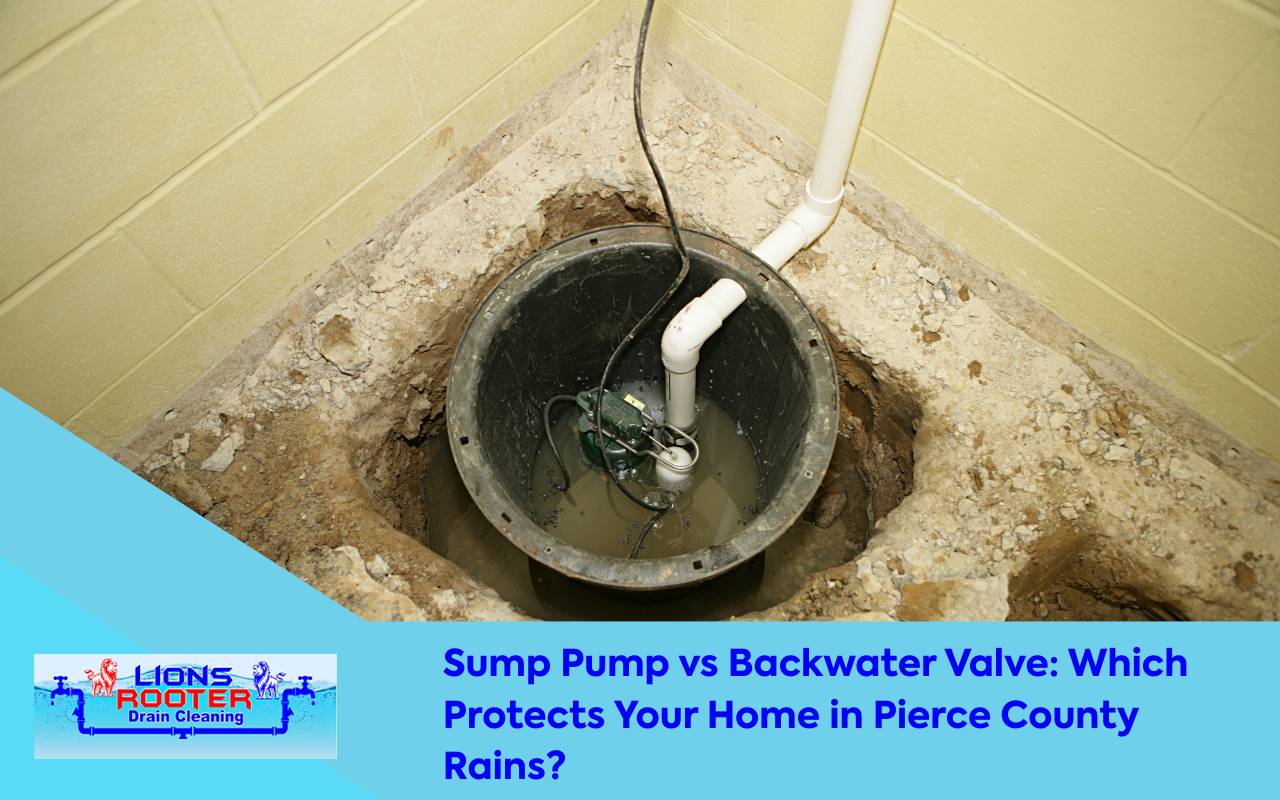Our Blog
Home / Our Blog

Sump Pump vs Backwater Valve: Which Protects Your Home in Pierce County Rains?
Protecting your home from flooding during Pierce County’s heavy rain season requires smart preparation. With unpredictable weather patterns, comparing a sump pump vs a backwater valve becomes vital. Each system serves a distinct purpose, but complements the other when preventing water intrusion. Understanding these solutions helps homeowners make confident decisions and avoid stressful sewer backups during storms.
A sump pump removes water from the basement to prevent flooding, while a backwater valve blocks sewage from flowing back inside. Both offer unique benefits based on property layout and infrastructure. Choosing correctly ensures your home stays dry and safe, even during the heaviest rainfalls.
Understanding the Role of a Sump Pump
The main function of a sump pump is to remove excess groundwater beneath your home’s foundation. Installed in a sump basin, it activates when water levels rise above a set point. It then pumps the collected water through a discharge line, keeping basements dry and preventing mold growth. In Pierce County’s rainy months, this device serves as a critical defense against flooding.
A sump pump collects water through a pit under the basement floor.
The float switch activates the motor as water rises.
Water is expelled through a discharge line and directed away from the foundation.
While examining sump pump vs backwater valve, it’s clear that a sump pump handles groundwater intrusion, whereas a backwater valve protects against sewage inflow. However, using both ensures complete flood protection for Pierce County homes.
Benefits of Installing a Sump Pump
Installing a sump pump offers several advantages for homeowners. It prevents basement flooding, maintains dry living conditions, and reduces structural damage. It also helps improve indoor air quality by minimizing dampness that fosters mold and allergens. For Pierce County properties, this system acts as the first line of defense against recurring rainfall issues.
Automatic activation during rising water levels.
Improved property value with proactive flood prevention.
Reduced maintenance costs over time through consistent protection.
To explore professional installation options, visit the services page for complete details on sump pump and backwater valve solutions.
Exploring the Functionality of a Backwater Valve
A backwater valve prevents sewage from backing up into your home during heavy storms. It is installed on the main sewer line and uses a flap or gate that opens outward for wastewater but closes if sewage attempts to flow back. This design ensures that contaminated water never re-enters your drains.
Protects against municipal sewer overloads.
Operates automatically during heavy rain events.
Requires minimal maintenance after installation.
When comparing sump pump vs backwater valve, the backwater valve focuses on blocking backflow from city sewers, offering protection where sewer systems may overflow.
Advantages of Having a Backwater Valve
Installing a backwater valve provides peace of mind and dependable sewer backup prevention. It protects your property’s sanitation during rainfall surges and keeps wastewater from contaminating indoor plumbing. Insurance companies often value this preventive measure, sometimes offering lower premiums for homes with installed valves.
Additionally, maintaining a backwater valve is simple. Periodic cleaning of the flap and hinge ensures proper function. Homeowners can rely on this device for long-term flood resilience with minimal upkeep. Combined with a sump pump, this system creates comprehensive flood defense.
Factors to Consider When Choosing Between a Sump Pump and Backwater Valve
Evaluating sump pump vs backwater valve requires considering your property’s specific vulnerabilities. Homes with groundwater issues benefit most from a sump pump, while those in areas prone to sewer backups require a backwater valve. Reviewing soil type, drainage layout, and municipal sewer reliability helps identify the correct system.
Determine if your home faces groundwater infiltration or sewer backup risk.
Consider installation requirements and local building codes.
Assess maintenance preferences and power reliability for pump systems.
For professional assistance in evaluating your property, use the contact page to speak with experienced technicians who can recommend the best flood prevention solution.
Maintenance Requirements for Sump Pumps and Backwater Valves
Both systems require periodic maintenance to function properly. For a sump pump, check the float switch and remove debris from the basin regularly. Test the pump before rainy seasons to ensure readiness. Verify the discharge line’s check valve prevents water from returning to the pit.
For backwater valves, inspect the access cover every six months. Clean the flap mechanism and confirm that wastewater exits freely. Scheduling routine professional inspections ensures these systems perform during critical moments, reducing the chance of flooding.
FAQs About Sump Pump and Backwater Valve Systems
How does a sump pump differ from a backwater valve?
A sump pump removes groundwater, while a backwater valve blocks sewage from backing up into your home’s plumbing system.
Can I install both systems together?
Yes, many Pierce County homeowners combine both for complete flood protection, covering groundwater and sewer backup risks.
How often should I inspect these systems?
Inspect sump pumps quarterly and backwater valves twice yearly. Regular maintenance ensures reliable performance during storms.
Do I need professional help for installation?
Professional installation is highly recommended. Proper setup ensures efficiency and compliance with Pierce County regulations.
Where can I find reliable maintenance services?
You can visit the services page or use the contact page to schedule expert assistance and inspections.
Making the Right Choice for Your Home's Flood Protection
Deciding between a sump pump vs backwater valve depends on your home’s unique flood risks. Both offer essential protection, and many homeowners benefit from installing both systems together. Assessing your location, soil type, and sewer system performance helps ensure the right investment.
By combining expert advice, reliable equipment, and routine maintenance, Pierce County homeowners can secure their properties against unpredictable rainfall. For tailored flood prevention solutions, visit the services page today and protect your home for the seasons ahead.
We Accept Cash, Check, and Credit Card Payments.

@ 2025 - Lions Rooter Drain Cleaning | All Rights Reserved







